Princeflex
The Princeflex (プリンスフレックス) and Prince Junior (プリンスジュニア) are Japanese 6×6 TLR cameras, distributed from 1953 to 1956 by Mima Shōkai. The Princeflex and Princeflex II were made by Tōyō Seiki Kōgaku. The Prince Junior was certainly made by a successor of that company, perhaps Cosmo Camera Seisakusho, except for the last cameras with capital markings, which were certainly made by Tougodo.
The postwar Princeflex has no resemblance to the 1937 Prince Flex.[1] (See the Prince page for a discussion of the various cameras with that name.)
Contents
Maker
Both the camera markings and the original documents reveal that the Princeflex and Princeflex II were made by Tōyō Seiki Kōgaku, which was also the maker of the Elbowflex and Elbow Six. The Elbowflex and Princeflex are very similar and shared a number of parts.
The name Tōyō Seiki Kōgaku no longer appears after mid-1955, and there are hints that the company was renamed Cosmo Camera Seisakusho (Kosumo Kamera Seisakusho). It is therefore extremely probable that the Prince Junior, successor of the Princeflex, was made by Cosmo. Only the last model with capital markings is a completely different camera, certainly a name variant of the Toyocaflex by Tougodo.
All the models were distributed by the wholesale dealer Mima Shōkai, based in Ōsaka, certainly the owner of the "Prince" brand name. This company used the name "Prince Camera Works" (プリンスカメラワークス, Purinsu Kamera Wākusu) in the advertisements, in association with a stylized "PCW" logo — just like advertisements for prewar Prince cameras. Some sources interpret this as a company name,[2] but it is near certain that "Prince Camera Works" was just a dummy name used for advertising (see Camera Works).
General description
The Princeflex and Prince Junior are regular copies of the Rolleicord. Focusing is by a knob on the right side, sliding the whole front plate. The film advance knob is on the photographer's right too. There is a magnifying lens and a sports finder in the viewing hood. The name Prince flex or Prince Junior is inscribed on a stepped nameplate above the front plate.
All the models have 80/3.5 viewing and taking lenses. The release button is placed at the bottom of the front standard, actuated by the photographer's right hand fingers.
Princeflex

|
| Princeflex, original model, no.1012. (Image rights) |
The original Princeflex has knob advance controlled by red window, and it can also take 4.5×6 pictures with a mask. There are two red windows, one for each format, placed side by side at the bottom of the back and protected by a horizontally sliding common cover. The leather case has corresponding holes for the red windows.
The camera has Luminar Anastigmat lenses and a TSK shutter (B, 1–200, self-timer), certainly made by Tōyō Seiki Kōgaku itself. The shutter release has a lock, which seems to consist of a pivoting cover containing a thread for a cable release. The ASA synch post is buried in the front plate, opposite the shutter button. The focusing knob is surrounded by a depth-of-field scale. The camera has no accessory shoe. It seems that the lenses can take push-on filters of two different diameters, as on most Elbowflex cameras.
The company name and the serial number are engraved under the Prince flex name plate. The name Princeflex is embossed at the top of the leather case, and a logo certainly reading TSK is embossed at the front.
The camera with body no.1001 — perhaps the first produced — slightly differs from later examples by the engraving of the company name, reading TOYOSEIKI OPT.CO.LTD.[3] Regular production cameras have TOYOSEIKI OPTICAL CO. LTD. instead. The change was applied very soon, and is already visible on body no.1012 whose picture appears on some of the advertisements reproduced below. The highest body number confirmed so far is 1811.[4]
The original Princeflex was first announced in July 1953, and was advertised in Japanese photography magazines for about a year starting from the August 1953 issues.[5] The advertisements reproduced below were placed in Asahi Camera by the distributor Mima Shōkai.[6] They mention Tōyō Seiki Kōgaku as the manufacturer, and they display the name "Prince Camera Works" and the "P.C.W." logo. All give the same price of ¥17,000.
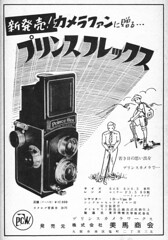
|
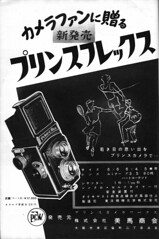
|

|
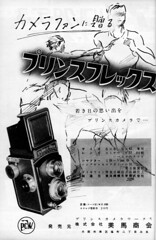
|

|
| September and October 1953 | November 1953 | January to March 1954 | April to June 1954 | July and August 1954 |
| Advertisements for the Princeflex in Asahi Camera. (Image rights) | ||||
Princeflex II
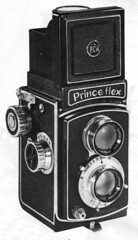
|
| Princeflex II, no.2204. (Image rights) |
The Princeflex II or Princeflex 2[7] has semi-automatic film advance rather than red windows. As a consequence it has lost the ability to take 4.5×6cm exposures. The advance is unlocked by pressing the center part of the advance knob. There is a round window for an exposure counter at the top of the right-hand plate. It seems that the position of the first exposure is set by aligning the arrows on the film paper backing to a red dot inside the camera, then the exposure counter mechanism is engaged by a button placed behind the focus knob.
The lenses are Super Luminar 80/3.5. The shutter is the same TSK (B, 1–200, self-timer) as on the previous model. The release button has a simpler shape, with a thread for a cable release and a collar used as a shutter lock. It is not known if it is interlocked with the advance mechanism for double exposure prevention. The synch post is of the PC type and is buried in the left-hand plate, at the bottom (as on the Prince Junior). There is also an accessory shoe on the same side. The back latch has changed, and is now the same as on the early Elbowflex.[8]
The Princeflex II, unlike other models, has a P.C.W. logo above the viewing hood. Under the nameplate, it has the same TOYOSEIKI OPTICAL CO. LTD. and serial number engraving as the original model. The original box is gray and is marked Prince FLEX MODEL II in golden letters.[9]
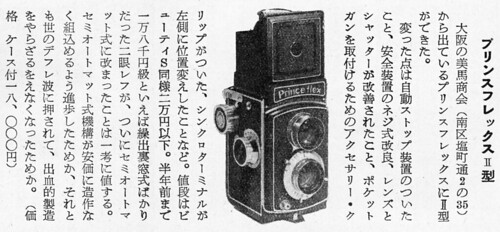
|
| Announcement of the Princeflex II in Asahi Camera October 1954. (Image rights) |
The camera was featured as a new product in the October 1954 issue of Asahi Camera, reproduced below.[10] It was also advertised in Japanese photo magazines dated from September 1954 to April 1955.[11] The advertisements reproduced below were placed in Asahi Camera during that period.[12] These documents display the same company names as the advertisements for the previous model, and list the camera for ¥18,000. All show the same picture of body no.2204.
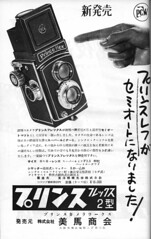
|
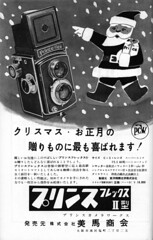
|
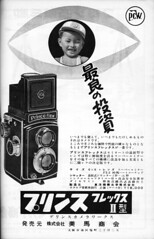
|
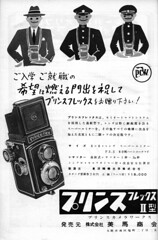
|
| September to November 1954 | December 1954 | January and February 1955 | April 1955 |
| Advertisements for the Princeflex II in Asahi Camera. (Image rights) | |||
Prince Junior
The Prince Junior was introduced as a less expensive camera (¥9,500). It has semi-automatic film advance with an exposure counter and start marks, the same as the Princeflex II. There is no depth-of-field scale and no cable release connector. The accessory shoe and PC synch post are placed the same as on the Princeflex II. The back latch has changed again, and is the same as on the late Elbowflex. The serial number is engraved above the Prince Junior nameplate, and the company name has disappeared from the camera.

|
| Prince Junior, no.6014. (Image rights) |
The Prince Junior has J-Luminar 8cm f/3.5 viewing and taking lenses. Those have three elements[13] and are probably inferior to the Luminar and Super Luminar mounted on earlier models. The camera normally has a Ceres shutter (B, 1–300, self-timer). The chrome lens cap covers both lenses and is engraved Prince on the upper part.

|
| Announcement of the Prince Junior in Asahi Camera November 1955. (Image rights) |
This model was first announced in September 1955.[14] The advertisements reproduced below were placed in Asahi Camera from September 1955 to February 1956.[15] The camera was also featured as a new product in the November 1955 issue of the same magazine, reproduced above.[13]
The September 1955 advertisement, placed before the public release, shows a sort of lottery: people were asked to guess the camera's release price, and among the correct answers, three persons would win a Prince Junior.[16] The correct answer would be published in the October 1955 issue of the magazine; the advertisement published the following month indeed shows the price of ¥9,500, a sure indication that the TLR boom was close to the end. The advertisements placed in the December 1955 and January 1956 issues say that the Prince Junior "is not above Rollei, but the results are the same" (ローライ以上とは申しませんが写した結果は同じです!). The documents show the names of Mima Shōkai and "Prince Camera Works", and sometimes the "P.C.W." logo, but do not mention Tōyō Seiki Kōgaku any longer, perhaps because the company changed its name.
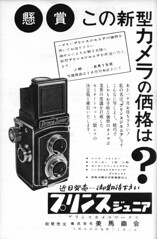
|
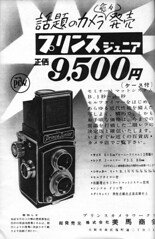
|
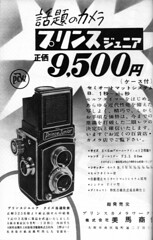
|
| September 1955 | October 1955 | November 1955 |

|

|

|
| December 1955 | January 1956 | February 1956 |
| Advertisements for the Prince Junior in Asahi Camera. (Image rights) | ||
The original Prince Junior is normally found with the Ceres shutter, but at least one isolated example is known with a Rectus shutter (perhaps B, 1–300) and J-Luminar lenses.[17] Body numbers are known in the 6xxx, 7xxx and 9xxx range, accounting for a total production of about 10,000 units. It is not known if this total includes other models made by Tōyō Seiki Kōgaku, such as the Elbowflex or Easternflex.
Prince Junior, capital letters
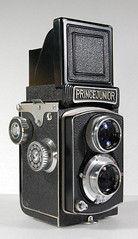 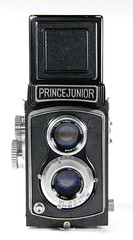 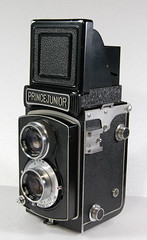
|
      
|
| Prince Junior, capital letters, Rectus shutter (B, 1–300), Tri-Lausar Anastigmat 8cm f/3.5 taking lens no.555086, Tri-Lausar Viewer 8cm f/3.5 viewing lens no.555429. Pictures by Hans Kerensky. (Image rights) |
A few late examples of the Prince Junior have the name written as PRINCE JUNIOR in capital letters, on a different nameplate.[18] These cameras differ from the above model in various respects: the machining of the body casting, the position of the exposure counter, the shape of the strap lugs and back latch, and details of the viewing hood. This version actually seems to correspond to a name variant of the Toyocaflex by Tougodo, to which it is extremely similar. This model does not appear in the Japanese documents found so far, and was perhaps made for export only.
These cameras have a Rectus shutter (B, 1–300, self-timer) and Tri-Lausar 8cm f/3.5 lenses made by Tomioka. At least one example has a serial number engraved above the nameplate, apparently consisting of five digits, whereas the others have no visible serial number.[19] Some examples, including that pictured above, have a film reminder inside the focus knob, which is absent on other cameras;[20] this film reminder is similar to that found on other name variants of the Toyocaflex.
Notes
- ↑ Lewis, p.82, says that the Princeflex was "a revived prewar design" but this is a mistake.
- ↑ For example Sugiyama, item 2225, and McKeown, p.803, mention a company called "Prince Camera Co.", which is probably an imaginary back-translation of プリンスカメラワークス.
- ↑ Example pictured in a Japanese website which is now dead.
- ↑ Example pictured in this page of wanted cameras at tlr-cameras.com.
- ↑ Kokusan kamera no rekishi, p.363.
- ↑ Advertisements in Asahi Camera September 1953, p.67, October 1953, p.61, November 1953, p.141, January 1954, p.184, February 1954, p.104, March 1954, p.92, April 1954, p.173, May 1954, p.103, June 1954, p.107, July 1954, p.114, and August 1954, p.52. That dated September is also reproduced in Kokusan kamera no rekishi, p.176, and that dated April to June is reproduced here at Shashin-Bako.
- ↑ The name is given as "Princeflex 2" (プリンスフレックス2型) in a few early advertisements and as "Princeflex II" (プリンスフレックスⅡ型) in other documents and on the original box.
- ↑ Compare the picture of the Princeflex II with the Elbowflex displayed here at Minosan's blog.
- ↑ Example observed in an online auction.
- ↑ Column in Asahi Camera October 1954, p.203.
- ↑ Kokusan kamera no rekishi, p.363.
- ↑ Advertisements in Asahi Camera September 1954, p.108, October 1954, p.117, November 1954, p.49, December 1954, p.113, January 1955, p.120, February 1955, p.158, and April 1955, p.179. That dated September is also reproduced in Kokusan kamera no rekishi, p.177.
- ↑ 13.0 13.1 Column in Asahi Camera November 1955, pp.169–70.
- ↑ Kokusan kamera no rekishi, p.363.
- ↑ Advertisements in Asahi Camera September 1955, p.153, October 1955, p.89, November 1955, p.109, December 1955, p.116, January 1956, p.140, and February 1956, p.112. Those dated September and October 1955 and January 1956 are also reproduced in Kokusan kamera no rekishi, p.177. The same source also mentions advertisements in the March and April 1956 issues of Asahi Camera, but these do not actually appear in the copies of the magazine.
- ↑ Advertisement reproduced in Kokusan kamera no rekishi, p.177.
- ↑ Example observed in an online auction.
- ↑ Examples pictured in this page, in McKeown, p.803, and observed in online auctions.
- ↑ Serial number: example pictured in McKeown, p.803.
- ↑ Film reminder: examples pictured in this page and in McKeown, p.803.
Bibliography
Original documents

|
| Princeflex II in Shashin Kōgyō January 1955. (Image rights) |
- Asahi Camera October 1954. "Shinseihin memo" (新製品, New products memo). P.203.
- Asahi Camera November 1955. "Shashin-kai nyūsu" (新製品, News of the photography world). Pp.169–70.
- Asahi Camera. Advertisements by Mima Shōkai:
- September 1953, p.67;
- October 1953, p.61;
- November 1953, p.141;
- January 1954, p.184;
- February 1954, p.104;
- March 1954, p.92;
- April 1954, p.173;
- May 1954, p.103;
- June 1954, p.107;
- July 1954, p.114;
- August 1954, p.52;
- September 1954, p.108;
- October 1954, p.117;
- November 1954, p.49;
- December 1954, p.113;
- January 1955, p.120;
- February 1955, p.158;
- April 1955, p.179;
- September 1955, p.153;
- October 1955, p.89;
- November 1955, p.109;
- December 1955, p.116;
- January 1956, p.140;
- February 1956, p.112.
- Shashin Kōgyō no.31, January 1955. "Kokusan kamera sōran" (日本のカメラ全貌・二眼レフカメラ・スプリングカメラ, Panorama of Japanese cameras). P.63.
Recent sources
- Asahi Camera (アサヒカメラ) editorial staff. Shōwa 10–40nen kōkoku ni miru kokusan kamera no rekishi (昭和10–40年広告にみる国産カメラの歴史, Japanese camera history as seen in advertisements, 1935–1965). Tokyo: Asahi Shinbunsha, 1994. ISBN 4-02-330312-7. Items 792–4.
- Lewis, Gordon, ed. The History of the Japanese Camera. Rochester, N.Y.: George Eastman House, International Museum of Photography & Film, 1991. ISBN 0-935398-17-1 (paper), 0-935398-16-3 (hard). Pp.82 and 88 (brief mentions only).
- McKeown, James M. and Joan C. McKeown's Price Guide to Antique and Classic Cameras, 12th Edition, 2005-2006. USA, Centennial Photo Service, 2004. ISBN 0-931838-40-1 (hardcover). ISBN 0-931838-41-X (softcover). P.803.
- Sugiyama, Kōichi (杉山浩一); Naoi, Hiroaki (直井浩明); Bullock, John R. The Collector's Guide to Japanese Cameras. 国産カメラ図鑑 (Kokusan kamera zukan). Tokyo: Asahi Sonorama, 1985. ISBN 4-257-03187-5. Item 2225.
- Takasaki Akio (高崎晶夫). "Kokusan 6×6cm-han nigan-refu A to Z" (国産6×6cm判二眼レフA to Z, Japanese 6×6cm TLR A to Z). Kamera Rebyū: Kurashikku Kamera Senka (カメラレビュー クラシックカメラ専科) / Camera Review: All about Historical Cameras no.49, December 1998. ISBN 4-257-13022-9. Amerika-sei 35mm renzu-shattā kamera (アメリカ製35mmレンズシャッターカメラ, issue about American 35mm lens-shutter cameras). Pp.64–73. (Shows no picture of the Princeflex or Prince Junior.)
Links
In English:
- Pages at Barry Toogood's tlr-cameras.com:
- Princeflex I among wanted Japanese cameras
- Prince Junior among various Japanese TLRs
In Japanese:
- Prince Junior at www.tlr66.com
- Princeflex specs (archive.org) at Japan Family Camera
- Advertisement for the Princeflex dated 1954, reproduced in Shashin-Bako